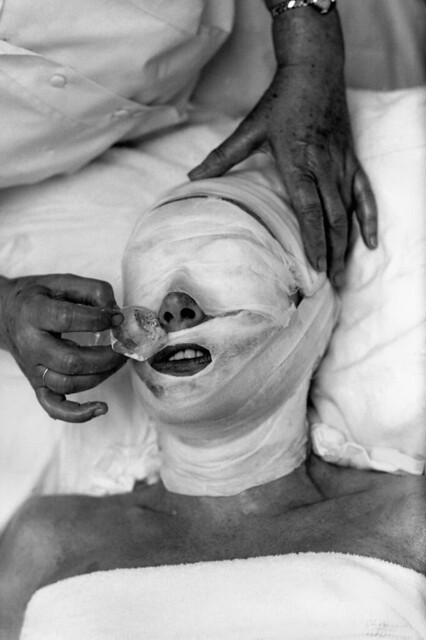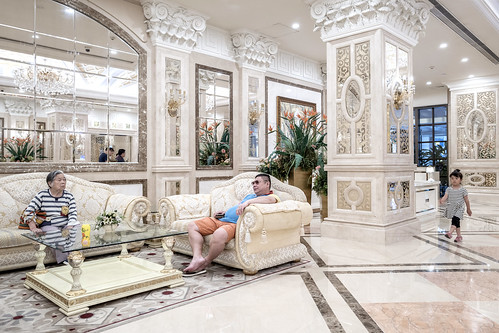Tuesday, 5:22pm
23 July 2019
Banquet of images
Eve Arnold
Steeve Bauras
Ken Grant
Ouka Leele
Pixy Liao
Christian Lutz
László Moholy-Nagy
Martin Parr
Alys Tomlinson
Photography
Critique / Photography
For its 50th anniversary, the Arles festival stages a
generous array of contemporary and historical
exhibitions. Photo Critique by Rick Poynor.

Photo Critique by Rick Poynor, written exclusively for Eye magazine.
I first visited the photography festival in Arles in 1986. I don’t know why it took me 22 years to go back. Since 2008 I have attended Les Rencontres de la Photographie – to use the correct title – eight times. I would go every year if I could. This year the festival is 50 and it is celebrating its longevity and its immense contribution to French and world photographic culture with 50 exhibitions (until 22 September 2019). This banquet is par for the course. Every year Arles’s curators deliver several dozen exhibitions, many of them on a scale one might expect from a national gallery of art, and document the event in a hefty and handsome souvenir catalogue.
The exhibitions are spread across a historic town that is spectacularly picturesque and a low-key tourist attraction in its own right. In 2008, the heart of Rencontres was still the Parc des Ateliers, a disused railway repair yard where the vast, decommissioned sheds could house a labyrinth of exhibitions. It was a wonderfully informal and beguiling set of spaces. Now an aluminium-clad tower by Frank Gehry, erected by the Luma Foundation, looms over the site and the festival’s summer-long presence has been reduced to just two refurbished ateliers. These are still impressive art spaces, but compared to the rough vigour of former days they feel a little bloodless.
The festival organisers have grappled with the park’s descent into gentrification by finding new disused venues in the town. A site called Croisière has emerged as a hub – it houses twelve exhibitions this year, as well as a bookshop and hanging-out areas. Up the road, another abandoned site, dubbed the Maison des Peintres, plays host to five more shows, including ‘The Anonymous House Project’, an entire house imaginatively fitted out with retro furnishings for an amusing exhibition devoted to vintage colour slides of people enjoying their dwellings. An open fridge acts as a giant light box for a picture of a woman standing at her cooker; a screen positioned like a painting above a table set for a meal displays shots of families in their dining rooms.
The kitchen at ‘The Anonymous House Project’. Photo: Rick Poynor.
Top. Ouka Leele, Peluquería, 1979. Courtesy of the artist.
Ken Grant, Lisa and Tracy's sister, Birkenhead, 1990 (‘Home Sweet Home’ exhibition).
In the same stripped-out complex of buildings, ‘Home Sweet Home’ offers a more serious and sociological ‘political history’ of the British at home from 1970 to 1980. Some of this is wince-making for a British visitor. The German photographer Karen Knorr’s ‘Belgravia’ series from 1979 presents the wealthy in their domiciles with pointed quotations under the pictures. ‘There is nothing wrong with Privilege,’ says one young toff in a bow tie, ‘as long as you are ready to pay for it.’ This is a superbly thorough piece of historical investigation that features material on the BBC’s notorious fly-on-the-wall documentary The Family made in 1974 and encompasses everything from punks putting their feet up at home to the domestic cocoon considered in terms of Gaston Bachelard’s concept of the poetics of space – French curators make demands on the viewer with exceptionally thorough labels and it usually pays off.
Martin Parr, Kleine Scheidegg, Switzerland, from the ‘Small World’ series, 1994. Martin Parr / Magnum Photos.
The survey shows are particularly strong this year. The archaeological museum on the far side of town – a delightful walk along the river – has an exhibition documenting the use of postcard imagery in art by Susan Hiller, Stephen Shore, John Stezaker, Martin Parr, and others. This is part of a theme titled ‘The Other Photography’ that investigates vernacular and non-professional practices. The 500 pieces in ‘Photo | Brut’ make the case for the existence of a photographic genre equivalent to Art Brut (or outsider art) produced by individuals who sometimes had mental health problems. A bizarre highlight is the series of photos found in a briefcase in an abandoned apartment, which document in obsessive detail the affair, in 1969-70, between Margret S., a secretary, and Günter K., a Cologne businessman, who took hundreds of pictures of her, and kept weirdly meticulous and sexually explicit notes about their meetings. This haunting project may be unique. The pair are presumed to be dead.
László Moholy-Nagy, Funkturm Berlin, 1928.
Other survey exhibitions of note are ‘La Movida’, chronicling a decade of social turmoil and flamboyant pop culture in post-Franco Spain (Ouke Leele’s picture of a ‘hairdo’ fashioned from lemons forms the Rencontres visual identity this year); an eye-opening introduction to the ‘Zone’, a 250-metre-wide strip of land around Paris used for defensive purposes and then inhabited by the poor and other marginals for around 100 years; and a brilliant show about the role of photography in the avant-garde Belgian magazine Variétés (1928-30) with pictures by Germaine Krull, Eli Lotar, László Moholy-Nagy, and many others. There are always history lessons aplenty at Rencontres and this year they also include Helen Levitt’s remarkably unconstrained pictures of children playing in the streets of mid-twentieth-century New York and ‘Unretouched Women’, showcasing three key 1970s feminist photobooks about women’s lives and experiences by Eve Arnold, Abigail Heyman and Susan Meiselas.
National Scientific and Industrial Research and Inventions Office, Georges Mabboux’s acoustic horns to locate aircraft,
31 May 1935. CNRS collection A_3264. (‘The Saga of Invention’ exhibition).
In this exceptionally rewarding line-up, exhibitions devoted to individual contemporaries have to work hard make an impression. Christian Lutz’s panoramic visual indictments of casino culture in Las Vegas and Macao verge on hallucination; his control of lighting is so complete that it is hard to distinguish the ‘real’ from the staged. In ‘Datazone’, Philippe Chancel’s global travels have delivered images of crisis – from Afghanistan to Bulgaria, from Nigeria to Detroit – pervaded by what the curators call a ‘sick beauty’. From Antarctica, Chancel brings back the unnerving scene of a huge area of melted ice in the shape of a fallen man. After planet-scale catastrophes the mind can barely grasp, the intimate personal focus of Chinese photographer Pixy Liao’s ‘Experimental Relationship’ with her ever-compliant boyfriend is almost a comfort. Seated at a kitchen table with a blank expression, she helps herself to a piece of melon balanced on his crotch as he obligingly does the honours with the picture timer.
Pixy Liao, Start your day with a good breakfast together, from the ‘Experimental Relationship’ series, 2009. Courtesy of the artist.
The ten new photographers nominated for the Louis Roederer Discovery Award 2019 are mostly of a high standard and better than last year’s. The public’s award went to British photographer-anthropologist Alys Tomlinson’s lyrical studies of Christian pilgrimage sites in Europe; I would probably have cast the same vote. The joint official winners, Máté Bartha (for pictures of military summer camps in Hungary) and Laure Tiberghien (for glowing Rothko-like abstracts), embody the award’s catholic scope. I was gripped by Steeve Bauras’ ‘White Dreams Extended’, which counterposes distorted footage of Second World War pilots and fighters with oneiric blow-ups of old photos paired with empty black space. Reading the introduction, with references to the making of a ‘new space-time’, I wondered whether Bauras himself could entirely explain what he is doing in this installation. But the images unite to convey the sensation that a deep historical and psychic trauma is being excavated and aired.
Alys Tomlinson, Untitled 18, from the ‘Ex-Voto’ series, 2016-18. Courtesy of the artist and Hacklebury Fine Art, London.
Steeve Bauras, White Dreams Extended n°01, Paris, 2007-16. Courtesy of the artist and YCOS-Project.
All images here are reproduced with the kind permission of the Arles festival press department.
Rick Poynor, writer, Eye founder, Professor of Design and Visual Culture, University of Reading
Eye is the world’s most beautiful and collectable graphic design journal, published quarterly for professional designers, students and anyone interested in critical, informed writing about graphic design and visual culture. It is available from all good design bookshops and online at the Eye shop, where you can buy subscriptions and single issues. You can see what Eye 98 looks like at Eye Before You Buy on Vimeo.









